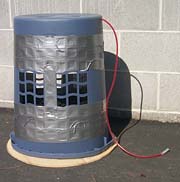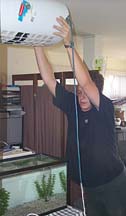
We’re really talking “homemade” here: calibrated laundry baskets and garbage bags. It’s not a big monetary investment, which makes it accessible to most residential contractors, said the re-searchers. They hope that contractors will, therefore, take such measurements more often, and that homeowners will act on their recommendations.
Iain Walker, Ph.D. and Member ASHRAE, is a staff scientist from Lawrence Berkeley National Laboratory (LBNL), Berkeley, Calif., who presented “Evaluation of Flow Capture Techniques for Measuring HVAC Grille Airflows.” He co-authored the paper with LBNL scientist Craig Wray.
According to the study’s results, in residential applications some of the commercial flow hoods tested had very large margins of error. “Maybe we could find some ways to do a little better, a little cheaper,” proposed Walker.

Why Do It?
There are good reasons for measuring airflow at the grille. After the installation of a new air conditioner, for example, “Most contractors will do things like start up the air conditioning and measure supply temperature,” said Walker. “Their concern is callbacks,” due to unit malfunctioning.However, “In humid states, you want to be on the low end of the manufacturer’s [airflow] specifications,” he said, for IAQ reasons.
The simpler devices can also be used for diagnosing major airflow problems, such as ductwork gaps and blockages that can result in customer comfort complaints.
Some homemade devices can be constructed so that they are suitable for balancing, though they may not be exact enough for measuring more subtle duct leakage, said Walker. On the other hand, he pointed out that “If you can’t get within 30 percent accuracy,” which was as close as some of the commercial devices came in residential applications, “can it really be called balancing?”
The paper states, “For many years, the HVAC industry has used flow hoods to measure grille airflows in nonresidential buildings, usually as part of a testing and balancing procedure; residential HVAC systems very rarely have been tested (unless by the research community). This is primarily because of [flow hood] sensitivity to flow nonuniformities and the difficulty in accounting for insertion losses on multiple low-pressure branch systems.
“Now utility programs, weatherization programs, and codes and standards such as California’s Title 24 are beginning to consider the need to commission residential HVAC systems. Such efforts include using flow hoods to determine if individual rooms are getting correct airflow and to estimate total air-handler airflow and duct air leakage.”

Hard Data
The researchers took detailed measurements at the lab and in the field. Results showed that commercial flow hoods “can be inadequate to measure airflows in residential systems, and there can be large measurement discrepancies between different flow hoods,” stated Walker and Wray. “These errors are due to poor calibrations, sensitivity of the hoods to grille airflow nonuniformities, and flow changes from added flow resistance.“It is possible,” they continued, “to obtain reasonable results using some flow hoods if the field tests are carefully done, the grilles are appropriate, and grille location does not restrict flow hood placement. Such conditions are not always found in real-world residential applications.
“We also evaluated several simple flow-capture techniques that could be adopted by the HVAC industry as simple diagnostics.”
The devices were evaluated using various measurement techniques under laboratory and field conditions, using single- and multiple-branch duct system tests.
“In particular, the single-branch lab tests allowed us to compare the flow-capture measurements to very precise airflow references,” Walker and Wray pointed out. “These single-branch tests are similar to the methods used by manufacturers to calibrate their flow hoods.”
The multibranch tests allowed the researchers to study insertion loss effects on flow hood performance.
“Insertion losses occur when the flow resistance of a capture device significantly changes the flow through an individual grille,” they explained. “Residential systems are particularly sensitive to this issue because grilles are placed at the end of short branches (with correspondingly low-pressure drops), such that the extra flow resistance of the capture device reduces the airflow through the grille being measured and redirects some of the airflow to other grilles in the system.”
The methods tested focused on reducing the cost and complexity of diagnostic airflow testing in residential applications. There was also some hope that homeowners would become interested in this rudimentary testing. At least, they may make “better informed choices about their HVAC systems.”

Homemade Devices
Walker first described a homemade basket hood. Commercially available basket flow hoods use calibrated resistance to measure flow through HVAC system grilles. There are commercially available household baskets with uniform holes the researchers used for calibration. They’re called laundry baskets.For calibration, Walker and Wray “systematically covered holes in the sides of the basket” using duct tape. “We optimized the position of the holes for the type of grilles (supply or return), because we found that holes too close to the flow entry have increased sensitivity to flow nonuniformity.” The number and size of holes also were optimized, “to produce a reasonably accurate pressure signal while minimizing backpressure results.”
Further enhancements were made to reduce flow nonuniformity effects. The baskets’ calibration was tested using a high-accuracy (±5 percent) flow nozzle. The baskets also required a pressure sensor in order to measure the pressure difference with sufficient accuracy.
The other homemade flow measurement device used bag-filling “technology.” This may not be as accurate as some commercial products, or even as the homemade basket flow hood. However, “If only a rough estimate of grille flows is required, filling a bag to estimate flows is a very inexpensive and simple alternative to expensive, commercially available flow hoods.”
In addition, “It’s much better than a contractor sticking his hand over the grille and telling a homeowner, ‘There’s not enough air coming out of here,’” said Walker.
A garbage/lawn waste bag is placed over the grille and the time required to fill the bag is measured using a stopwatch. “Because the volume of the bag is known, we can determine the flow by dividing the volume by the time,” said Walker.
“It also has the advantage that it gives a direct volumetric flow without relying on flow measurement techniques that only sample part of the flow, or assume a degree of flow uniformity as with almost all of the other techniques.”
In addition, “The bag filling has a direct visual element that is very appealing.”

Bag Enhancements
The paper explains, “Originally, bags were used as a way of quickly checking for HVAC system problems that did not require a flow to be measured to better than about 30 percent accuracy.” The study sought to quantify the uncertainties and find ways to improve that accuracy using simple techniques.The same calibration technique, the high-accuracy flow nozzle, was used on the bags as was used on the basket. Five bags were tested.

Test Results For Single-Branch Systems
The basket hoods had varying degrees of accuracy, ranging from ±3 percent for one-, two-, and three-way grilles, to about a 10-percent margin of error for three- and four-way grilles using a less complex basket.The bag-filling method first tested commercially available garbage bags that were in the lab. The other three were purchased from a hardware store. A lighter gauge plastic bag was unable to fill uniformly, and the bag folded over onto itself, according to Walker. “Bags four and five were constructed from a heavier gauge plastic and did not have this problem.”
While the bag’s results are more difficult to ascertain because of their higher degree of error, Walker said they are useful for determining large duct losses, such as those that might result from duct separation and blockage.
“Although the bag filling method appears crude,” stated the report, “the results of the bag testing can be used for almost all grille airflow diagnostics, with the exception of the requirement for duct leakage estimates (but even for that test, the 5 percent bias is very close to being acceptable). We found that the largest errors are for grilles whose flows are lower than about 40 cfm.”
In general, “The basket hood combines sufficient accuracy for most applications while being cheap and easy to use.”
Walker admitted that some contractors might have a problem using something that looks so very homemade. After all, image does count. However, he thought some clever contractors out there could create a device based on this information that combines good looks and high reliability.
The bags, on the other hand, offer great potential in this area, he said. Contractors could even order bags with their logos imprinted on them, and leave them in homes for homeowner reference if another family member needs to see this very graphic demonstration, said Walker.
A final note: “We are not the first people to fill bags of air,” Walker stated. He referred specifically to Canada Mortgage and Health, whose Web site gives information on how homeowners can perform an airflow-garbage bag test (http://www.cmhc-schl.gc.ca/en/burema/gesein/abhose/abhose_ce46.cfm).
Editor’s note: Some contractors have already been aware of the need for low-cost, effective, residential flow hoods and the opportunities that may result from their use. News contributor Howard Leonard has previously given instructions for creating a flow hood from a large cardboard box. That information can be found on The News Web site, www.achrnews.com.)
To contact Walker and Wray, visit the LBNL Environmental Energy Technologies Division Web site: http://eetd.lbl.gov.
Publication date: 07/28/2003

Report Abusive Comment